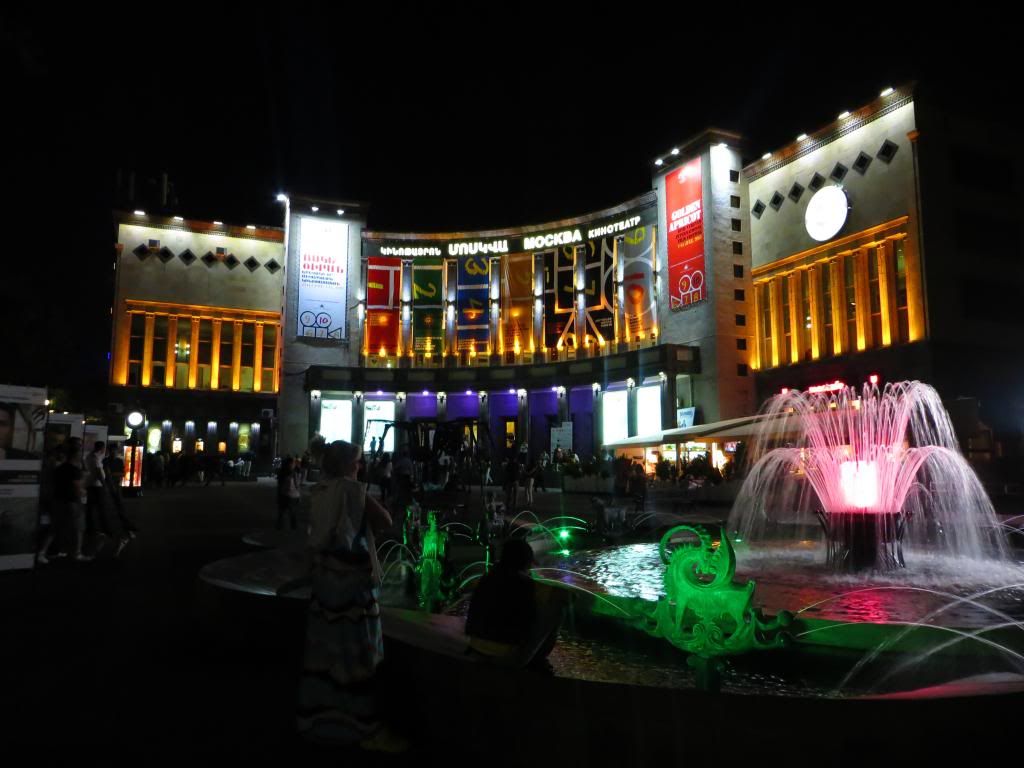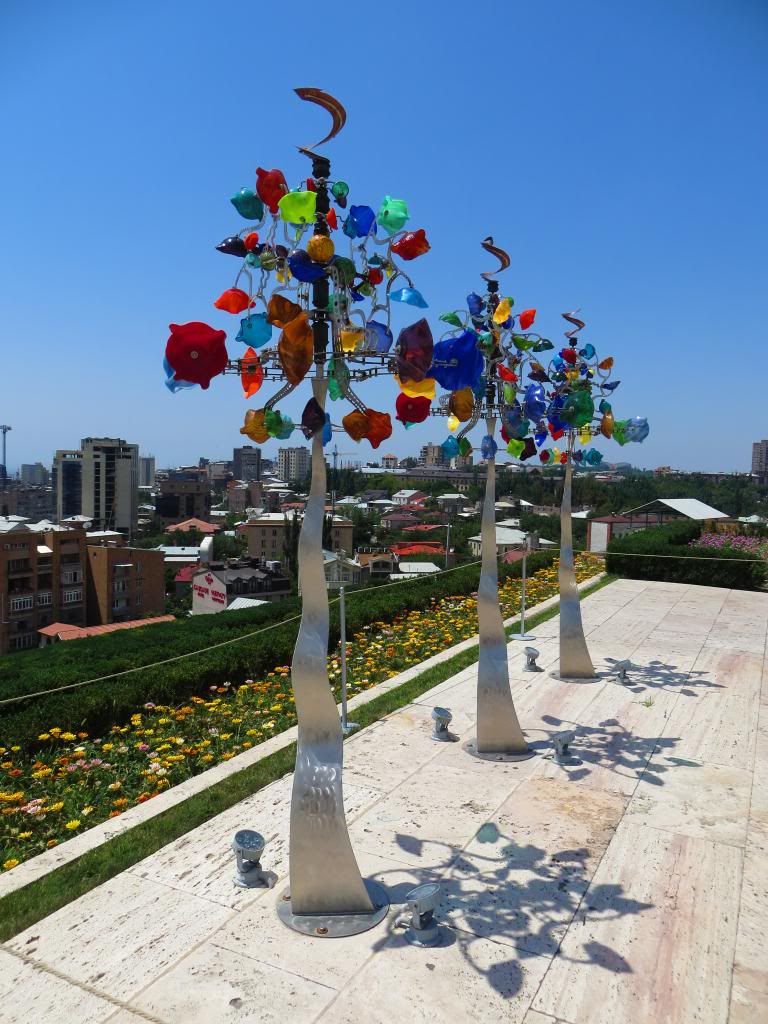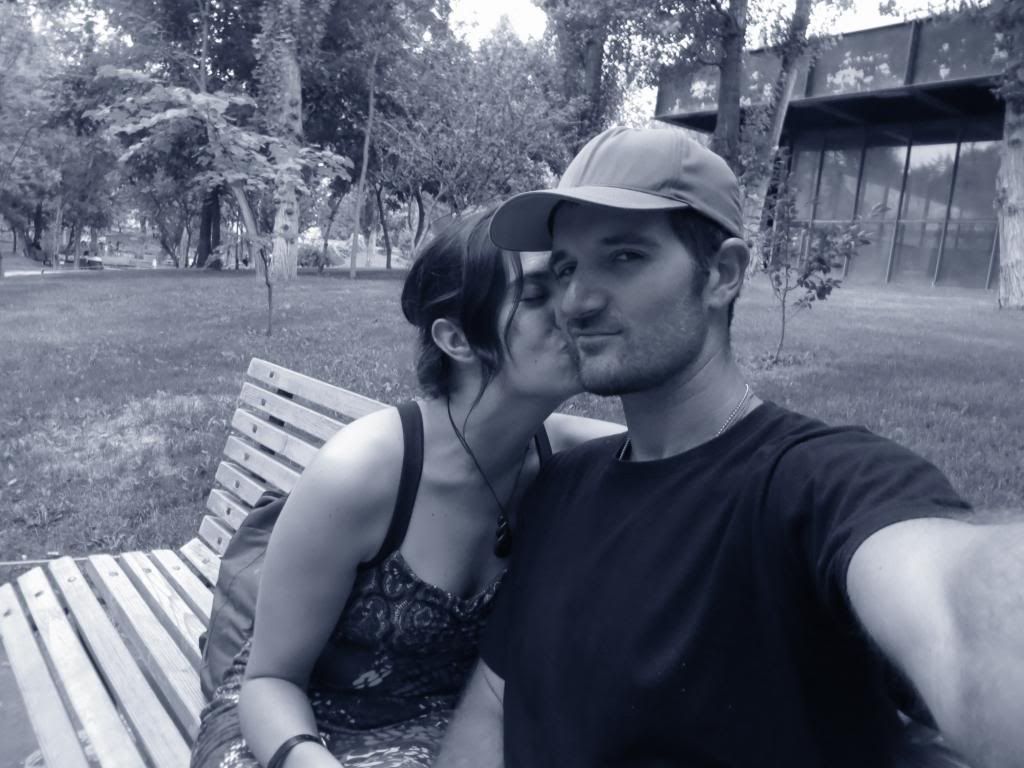Great (Un) Expectations
YEREVAN/GYUMRI/GARNI & GEGHARD, ARMENIA; TBILISI,
GEORGIA: July 13-16, 2013
Steve: At this
point in our travels we can safely say that Yerevan is the smallest capital
that we have yet to come across. I am not sure how it compares to other large
cities on a square mile basis, but at least in feel it is much, much smaller.
There are no towering skyscrapers looming over the downtown area, blocking
views in or out. Getting from one end of downtown to another is easily done—if
not enjoyable—on foot. As Leah has pointed out in past blog entries, one of her
biggest pet peeves is countries where pedestrians not only do not have the
right of way but are targeted like a sadistic game of real-life Frogger; if you
even seemingly think to set foot across the street in Yerevan cars slow down
and stop for you—this is definitely a walker’s city.
Somebody had mentioned to us at one point that Yerevan was
rather treeless since during the Soviet occupation Armenians had to cut down
street trees simply to burn for warmth. While some streets may be missing the
welcome shade of leafy green arbors, the city architects of days past seem to
have compensated with plenty of parks that are undoubtedly enjoyed by residents
and tourists alike. Indeed Leah and I spent much time in these parks taking
respite from all the walking done on warm summer days. We even spent an evening
picnicking with a bottle of a wine at the aptly mentioned Lover’s Park. Of
course with no open container laws—which we have yet to see abused anywhere on
our trip—like we have back in the States this was perfectly legal.
Venturing outside of Yerevan the sights quickly deteriorate
to rundown Soviet era projects and abandoned factories. Just because Yerevan is
clean, hip and bustling does not hide the fact that this is a poor country
still climbing its way out of a relatively recent history of war (with
Azerbaijan from 1991-1994), foreign (Soviet) occupation, natural disasters (a
1988 earthquake), and the identity-altering cultural and geographic schism of
the Armenian Genocide (1914-1918). All these events not withstanding people
do not seem to be miserably poor with homeless people huddled underneath
freeway overpasses like we might see in the States. I can only surmise that
this may be a holdover from Armenia’s days as a Soviet state—socialist ideals
at least dictate that the poorest still get a helping hand from their brethren.
We have yet to see Armenians on buses or trains not sharing food with others.
This leads me to the last and most important point of this
ramble—based on our short stay here Armenia might rank as one of the
friendliest countries on our trip. Even though security guards won’t let you
sit much less step foot on grass in public parks and even though curmudgeonly
old ladies on the metro will beat you at any stare down contest, the pervasive
feeling is that people are glad that we are here. Sure, they want and need the
tourist dollar—of course you don’t have to be a developing country to want to
capitalize on visitors—but Armenians seem to be genuinely proud of their
country and heritage and are truly grateful that you are here to experience it.
Ingrained in their genetic makeup is the DNA for sharing and giving and I would
be willing to bet that any visitor here would come across it—I know that we
did.
On our remaining days here we made it a point to see all
that we could while maintaining our sanity (Leah:
Given Yerevan’s central location and cheap accommodation we had decided to stay
in town and just take day trips the whole time, which many travelers end up
doing). One day was spent visiting the nearby town of Gyumri which with about
150,000 inhabitants is Armenia’s second largest city. Originally founded in the
4th century and known as Alexandropol, parts of the city still lay
in ruins from the devastating 6.8 Spitak earthquake that occurred back in 1988—most
notably the Church of the Holy Savior which is slowly being rebuilt but still
has a ways to go before it is finished. Given the wars and political upheavals
that have happened since then helps contextualize why repairs haven’t been
completed. The city itself was easily walkable and there wasn’t a whole lot to
do but that was kind of nice in itself. The morning train ride from Yerevan—complete
with boxes upon boxes of fruit cargo—was worth it just for the pleasant views
of the Armenian countryside.
Back in Yerevan we spent a good part of one of our days
visiting the iconic Cascade monument that joins the lower downtown area of
Yerevan with the higher northern section. Originally conceived in the early
part of the 20th century this edifice didn’t begin construction until
the 1980’s but was abandoned after the 1988 earthquake and was forgotten about
after the break-up Soviet Union in 1991. Construction did not resume until 2002 when
the City of Yerevan, with generous help from the obscenely rich
Armenian-American Gerald L. Cafesjian, acquired the necessary funding for a
project of this magnitude.
How to describe it The Cascade—it is essentially a massive
staircase meticulously constructed of stone, replete with water features,
carvings, creative landscapes and loads of art. Inside this staircase of sorts are terraced exhibition rooms with
everything from big name modern art, pop art, nationalistic murals and even a
Swavorsky crystal art exhibition. And the most staggering part of this is that
a large portion of this artwork is from the personal collection of the
aforementioned Mr. Cafesjian—which is also why the Cascades’ other official
name is the Cafesjian Center for the Arts.
From a construction standpoint this is one of the most innovative and aesthetically pleasing structures I have seen anywhere—I would think that architects and major cities around the world would be studying, imitating and trying to outdo Yerevan’s amazing museum-meets-park-space-meets-national-icon. Throw in the fact that it houses world-class art and it is not be missed (Leah: Amen to all that. This may be my favorite museum of the trip so far.)
From a construction standpoint this is one of the most innovative and aesthetically pleasing structures I have seen anywhere—I would think that architects and major cities around the world would be studying, imitating and trying to outdo Yerevan’s amazing museum-meets-park-space-meets-national-icon. Throw in the fact that it houses world-class art and it is not be missed (Leah: Amen to all that. This may be my favorite museum of the trip so far.)
The second to last day of our stay found us sucking it up
and taking a guided tour to the nearby sights of Garni and Geghard (Leah: Yes, it was a bit of a splurge,
but totally worth it to have a guide give all sorts of info and answer all our
questions, something that we don’t have the pleasure of when we do sites on our
own with only a guide book in hand). The former is the site of a reconstructed
pagan temple that was originally built in the first century in honor of the sun
god Mithra. The site also included the remains of an ancient church, a royal
home, fortress walls and a Roman bathhouse. The later still has a relatively intact
mosaic which has Greek lettering noting that the artists received nothing for
their work. Since it is in what was the royal dressing room it is debated whether
the artists were actually not paid for their toils or if there is some other
meaning behind it.
Moving on from Garni we visited the nearby monastery of
Geghard which was named after the lance that pierced Jesus’ side at the hands
of the Roman guard Longinus. According to legend he converted to Christianity
after regaining his sight when splashed by the blood and water pouring out of
Christ’s side. There are apparently several other lances that are purported to
be the very same (in Rome, Vienna and Krakow) however this lance is currently
stored in Echmiadzin which is the Armenian Apostolic Church’s version of the
Vatican. The monastery and adjacent chapels, cave dwellings and omnipresent
kochkars were well-preserved and some of the best we’ve seen on this trip.
Indeed before we knew it we found ourselves running to the tour bus since we
lost track of time amidst the atmospheric and hallowed depths of the church.
No blog entry would be complete without a mention of the
foodstuffs that we stuffed our faces with. Although I am going to miss the
hearty fares of Georgia—khinkali, ostri, lobiani, and khachapuri to name a few—Armenia
wins for being the creators of the lamachun
(pronounced “la-ma-joon”). Although Turkey has a version by the same name,
Armenia has perfected what I like to call the culinary crack cocaine of the
Caucuses (this alliterative catchphrase is currently copyright pending). This
pizza-ish creation is on a crispy thin crust and topped with cheese, meat and
parsley; not too much as we would probably do in the States but instead with just
the right proportions. Squeeze on some fresh lemon juice, roll up half of your
lamachun and you’re good to go. I cannot adequately describe the taste of this
wonder and won’t even attempt to try. All I can say is that it is a must-try if
you ever have the opportunity and if I can find a recipe that does it justice I
will make one for you back home in the States.
Leah: And we’d
also be remiss if we didn’t mention our new friend, Chant. We met him when the
three of us found ourselves in a four person dorm for a week and quickly
started sharing travel advice and conversations each day. Chant recently
graduated with his nursing degree from the American University of Beirut and
was in Yerevan to check out some of the sights, as his ancestry is Armenian. He
graciously answered all our questions about Lebanon and his travels and went
out of his way to give us advice and help us around Yerevan. He’d even managed
to score a Fulbright Scholarship to the US, only to have it rescinded when
funding problems arose- he’s in the process of securing one for next year
instead. The three of us even found ourselves sharing a bottle of pomegranate wine
on two different evening as we chatted about life, love, travel and vocations.
It wouldn’t have been the same without him and since we sincerely believe that
the people on this trip cross our paths for a reason we firmly hope to see
Chant again, whether in Lebanon or our neck of the woods in the US. And on an unrelated note, this little gem of an animated music video was played on the marshrutka back from Gyumri and we have to share it. According to Chant, the singer, Tata, always has long hair and a baseball hat and this image combined with a music video about Tata/Armenians being inserted into American/Hollywood history (complete with a hybrid Armenian/American flag) pretty much had us in stitches. Sorry we can't find translated lyrics but you definitely get the gist of it just by watching.
Steve: As I sit in
the Tbilisi International Airport putting the final touches on this blog entry
I am amazed at how fast the past three weeks have come and gone. We will be
moving on to Bulgaria before moving north through Eastern Europe and I am
excited for some of the places that we have on our itinerary—but I should
probably be just as excited for those that we haven’t yet to consider. Georgia
and Armenia weren’t on our radar as of a couple months ago and they have both
turned out to be hidden gems that we will be talking about for years to come.
Sleepy and travel-weary I can only dream about what unexpected treasures await
us….
CLICK FOR BUDGET SYNOPSIS OF ARMENIA
CLICK FOR BUDGET SYNOPSIS OF GEORGIA








We'll have to go to Little Armenia sometime when you're back. Maybe we can find some quality lamachun! "Hollyvood!"
ReplyDeleteYes please, we'll definitely be needing a fix by then!
ReplyDelete